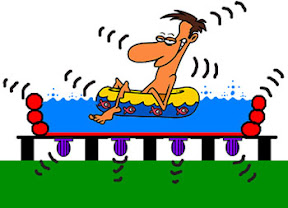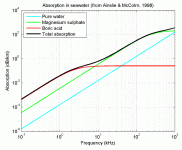Ok, so here is my plan:
A subwoofer that I can put in my pool so you can feel the music A LOT and maybe even cause the water to ripple.
My idea:
Make a submersible speaker out of plexiglass that employs an air pocket that separates the water from the speaker. Maybe fill the cavity with a really dense gas?
(or maybe just a water proof speaker???? idk...)
Has it been done before? And more importantly, what speaker parameters would change or be relevant when building this type of enclosure?
A subwoofer that I can put in my pool so you can feel the music A LOT and maybe even cause the water to ripple.
My idea:
Make a submersible speaker out of plexiglass that employs an air pocket that separates the water from the speaker. Maybe fill the cavity with a really dense gas?
(or maybe just a water proof speaker???? idk...)
Has it been done before? And more importantly, what speaker parameters would change or be relevant when building this type of enclosure?
Sound propagation through water requires different transducers than through air.Just buy one of the sub-shakers from PE and attach it to the pool. That should do the trick.
What kind of "trick" would "sub-shakers from PE" do ?
Where does one "attach it to the pool"?
I was thinking that if it is above ground pool, it could be attached to the side of the pool. Or make a sealed box that could sit at the bottom of the pool. These are attached to the bottom of your chair so you can "feel" the bass. Same thing, but in water. Here is a blurb from the P.E. link.
Bass Shakers work on the concept that low bass is mostly felt and not heard. The Aura Pro Bass Shaker literally sends sonic vibrations through the material it is attached to allowing you to feel the earth-shaking bass from your music, movies or video game soundtracks.
Aura AST-2B-4 Pro Bass Shaker
Bass Shakers work on the concept that low bass is mostly felt and not heard. The Aura Pro Bass Shaker literally sends sonic vibrations through the material it is attached to allowing you to feel the earth-shaking bass from your music, movies or video game soundtracks.
Aura AST-2B-4 Pro Bass Shaker
Has it been done before?
Clark Synthesis AQ339 Aquasonic Underwater Speaker
should give you some ideas
All I can find are synchronized swimming speakers, not vibrate the water speakers. That is why I think special underwater speakers have limitations on frequency response.
The pool is a soft body above ground pool, but I was hoping it could work in any pool,so I could sell some!
The pool is a soft body above ground pool, but I was hoping it could work in any pool,so I could sell some!
All I can find are synchronized swimming speakers, not vibrate the water speakers. That is why I think special underwater speakers have limitations on frequency response.
The pool is a soft body above ground pool, but I was hoping it could work in any pool,so I could sell some!
Underwater speakers all "vibrate the water".
Water does not transmit LF waves very well, as can easily be experienced when listening to the noise made by propellers under water. Even though the propellers are "moving a lot of water" at low frequencies, they sound like a fly buzzing under water.
1/. Make a standard sealed subwoofer enclosure. You may be able to get away with a smaller than usual box. Make the box shallow - wide and tall, but minimum depth front to back. Smooth the outside of the enclosure - no sharp or jagged edges.
2/. Put the box in a heavy (thick) plastic bag. The bag should be sized and pulled tight enough that the plastic is slightly loose across the driver opening, but not so loose that you can push it against the driver cone. Align the enclosure "face down" in the bag so that the bag closure (opening) is at the back of the enclosure, with the wire coming out. Airtightness is not essential, but tie it as tight as you can.
3/. Place the enclosure in the pool so that it floats face down. Feed it some bass. Job done...
2/. Put the box in a heavy (thick) plastic bag. The bag should be sized and pulled tight enough that the plastic is slightly loose across the driver opening, but not so loose that you can push it against the driver cone. Align the enclosure "face down" in the bag so that the bag closure (opening) is at the back of the enclosure, with the wire coming out. Airtightness is not essential, but tie it as tight as you can.
3/. Place the enclosure in the pool so that it floats face down. Feed it some bass. Job done...
Sorry Art, but I don't agree. LF does transmit very well trough water. Propellers do produce wide frequency range into water (close to wide range noise). However it is only the LF noise of those propellers that in most oceans today dominate the background noise below 100Hz.Underwater speakers all "vibrate the water".
Water does not transmit LF waves very well, as can easily be experienced when listening to the noise made by propellers under water. Even though the propellers are "moving a lot of water" at low frequencies, they sound like a fly buzzing under water.
The reason you don't hear much LF under water is only because our eardrums get damped in LF and HF by the water (liquid contact damping).
1/. Make a standard sealed subwoofer enclosure. You may be able to get away with a smaller than usual box. Make the box shallow - wide and tall, but minimum depth front to back. Smooth the outside of the enclosure - no sharp or jagged edges.
2/. Put the box in a heavy (thick) plastic bag. The bag should be sized and pulled tight enough that the plastic is slightly loose across the driver opening, but not so loose that you can push it against the driver cone. Align the enclosure "face down" in the bag so that the bag closure (opening) is at the back of the enclosure, with the wire coming out. Airtightness is not essential, but tie it as tight as you can.
3/. Place the enclosure in the pool so that it floats face down. Feed it some bass. Job done...
Don, I think that will need awful lots of power to generate some sound waves under water. From electric signal to a loudspeaker driver only < 10% of the energy (and that is for horn types) will be generated into sound. Of that small margin only < 10% will be transferred from air movement into the water. So think of 10kW to generate some 100 watts into water. Maybe 100 watts looks enough but it doesn't. The 100 watts will be heavily damped trough the mass of the water in your pool.
In my opinion, the ‘buttkicker’ is the most efficient way because it doesn’t use air in between but works as a contact sound-transmitter that direct radiates from the panel into the water. But still you’ll need quit some power the get over the damping factor of the mass of the water that is pressuring the panel.
And the schematic could look like this

Perhaps if you could get one of those hydraulic powered wave generator things to oscillate fast enough, that could work.
As far as anything that uses typical dynamic speakers or shakers, I'd think the first hurdle you'd be up against would be finding something that can take 10+ KW and then figure out how to get that into the water without accidentally feeding the power to your guests swimming at the same time.
Perhaps if you were to build a large bandpass style cabinet out of 1" lexan, and then instead of a port, build that end of the cabinet sealed also, but with a thinner (more flexible) piece of plastic that could resonate, so that the pressure of the cabinet was able to move it? You'd have to be really careful though, if you cracked it or it wasn't sealed properly, it'd be disaster.
As far as anything that uses typical dynamic speakers or shakers, I'd think the first hurdle you'd be up against would be finding something that can take 10+ KW and then figure out how to get that into the water without accidentally feeding the power to your guests swimming at the same time.
Perhaps if you were to build a large bandpass style cabinet out of 1" lexan, and then instead of a port, build that end of the cabinet sealed also, but with a thinner (more flexible) piece of plastic that could resonate, so that the pressure of the cabinet was able to move it? You'd have to be really careful though, if you cracked it or it wasn't sealed properly, it'd be disaster.
Agree on the shaker thing.
In order to generate the same amount of acoustic power into water you need to move less volume at a higher force than you would have to when generating sound in air. I.e. a driver that is built to generate sound in air would perform very inefficient in water (apart from all the other problems an ordinary driver would encounter under water).
One could build a special version of the usual moving coil driver with a very stiff suspension and a rigid watertight cone. The mass of the water loading the cone would give a very low resonant frequency.
Keep in mind that generating sound under water has SPL limitations due to cavitation. So a decent number of shakers would certainly help in this respect.
I remember a paberback on electronics for divers where they made an underwater speaker with one of these shaker thingies and a T******ware bowl.
Regards
Charles
In order to generate the same amount of acoustic power into water you need to move less volume at a higher force than you would have to when generating sound in air. I.e. a driver that is built to generate sound in air would perform very inefficient in water (apart from all the other problems an ordinary driver would encounter under water).
One could build a special version of the usual moving coil driver with a very stiff suspension and a rigid watertight cone. The mass of the water loading the cone would give a very low resonant frequency.
Keep in mind that generating sound under water has SPL limitations due to cavitation. So a decent number of shakers would certainly help in this respect.
I remember a paberback on electronics for divers where they made an underwater speaker with one of these shaker thingies and a T******ware bowl.
Regards
Charles
Love the schematic.Sorry Art, but I don't agree. LF does transmit very well trough water. Propellers do produce wide frequency range into water (close to wide range noise). However it is only the LF noise of those propellers that in most oceans today dominate the background noise below 100Hz.
The reason you don't hear much LF under water is only because our eardrums get damped in LF and HF by the water (liquid contact damping).
In my opinion, the ‘buttkicker’ is the most efficient way because it doesn’t use air in between but works as a contact sound-transmitter that direct radiates from the panel into the water. But still you’ll need quit some power the get over the damping factor of the mass of the water that is pressuring the panel.
And the schematic could look like this

You are correct, LF does transmit well through water, just like radio waves transmit well through air, but like radio waves, our ears or bodies do not sense them (unless you happen to have some weird dental problem L.O.L.)
As fishermen know, it takes a stick of dynamite exploding underwater to get a real "body blast" at much distance. My gut says bass shakers will have about as much LF "impact" as someone wiggling a spoon in a tub.
For a real tactile feel, a LF modulated water pump might be an effective use of power, one can really feel the jets of water used in many hot tubs.
Maybe a servo motor driven oar would give a good spanking...
Art
Oh, you mean blue toothunless you happen to have some weird dental problem L.O.L.
Sounds like you want to build a "water jet pulse modulator". Maybe difficult to make it frequency and time aligned but your idea would be much more effective then shakers for sure.For a real tactile feel, a LF modulated water pump might be an effective use of power, one can really feel the jets of water used in many hot tubs. Maybe a servo motor driven oar would give a good spanking...
Attachments
Last edited:
Oh, you mean blue tooth
Sounds like you want to build a "water jet pulse modulator". Maybe difficult to make it frequency and time aligned but your idea would be much more effective then shakers for sure.
Blue Tooth, that's good, but there was an episode of Gillagan's Island I was remembering when Gilligan developed a tooth cavity that could pick up ship's radio transmissions. Have to have a pretty dry mouth to grow crystals, but he was busted for marijiana later...
The OP wants a whole lotta shakin' goin on in the pool, I would far prefer to have the music airborne, unless scuba diving
Art
...
In order to generate the same amount of acoustic power into water you need to move less volume at a higher force than you would have to when generating sound in air. I.e. a driver that is built to generate sound in air would perform very inefficient in water (apart from all the other problems an ordinary driver would encounter under water).
...
I believe the driver would perform better coupled to water (even with a small air gap) than it does coupled to air. Remember, a driver cone is heavy compared to the air it moves, so is inefficient. Coupling to a heavier medium such as water must provide a better match.
Anyway, it is easy to test - you just need a sub and a heavy plastic bag, like the ones sold for garden waste (the plastic is thick to stop the branches and twigs from poking holes in the bag.) If you can't find a thick bag, most hardware / gardening supply stores sell various grades (thicknesses) of black plastic sheeting.
Finally, if your pool is soft sided, just push the face of the sub up against the side of the pool. Try and get an airtight seal.
- Status
- This old topic is closed. If you want to reopen this topic, contact a moderator using the "Report Post" button.
- Home
- Loudspeakers
- Subwoofers
- Subwoofer design to vibrate water in a pool?

